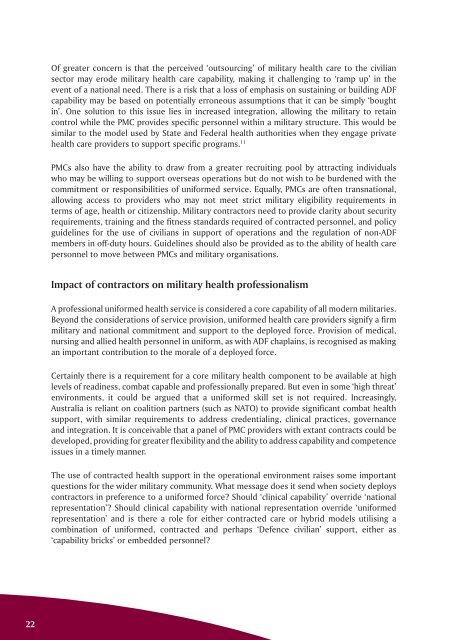ISSUE 182 : Jul/Aug - 2010 - Australian Defence Force Journal
ISSUE 182 : Jul/Aug - 2010 - Australian Defence Force Journal
ISSUE 182 : Jul/Aug - 2010 - Australian Defence Force Journal
Create successful ePaper yourself
Turn your PDF publications into a flip-book with our unique Google optimized e-Paper software.
Of greater concern is that the perceived ‘outsourcing’ of military health care to the civiliansector may erode military health care capability, making it challenging to ‘ramp up’ in theevent of a national need. There is a risk that a loss of emphasis on sustaining or building ADFcapability may be based on potentially erroneous assumptions that it can be simply ‘boughtin’. One solution to this issue lies in increased integration, allowing the military to retaincontrol while the PMC provides specific personnel within a military structure. This would besimilar to the model used by State and Federal health authorities when they engage privatehealth care providers to support specific programs. 11PMCs also have the ability to draw from a greater recruiting pool by attracting individualswho may be willing to support overseas operations but do not wish to be burdened with thecommitment or responsibilities of uniformed service. Equally, PMCs are often transnational,allowing access to providers who may not meet strict military eligibility requirements interms of age, health or citizenship. Military contractors need to provide clarity about securityrequirements, training and the fitness standards required of contracted personnel, and policyguidelines for the use of civilians in support of operations and the regulation of non-ADFmembers in off-duty hours. Guidelines should also be provided as to the ability of health carepersonnel to move between PMCs and military organisations.Impact of contractors on military health professionalismA professional uniformed health service is considered a core capability of all modern militaries.Beyond the considerations of service provision, uniformed health care providers signify a firmmilitary and national commitment and support to the deployed force. Provision of medical,nursing and allied health personnel in uniform, as with ADF chaplains, is recognised as makingan important contribution to the morale of a deployed force.Certainly there is a requirement for a core military health component to be available at highlevels of readiness, combat capable and professionally prepared. But even in some ‘high threat’environments, it could be argued that a uniformed skill set is not required. Increasingly,Australia is reliant on coalition partners (such as NATO) to provide significant combat healthsupport, with similar requirements to address credentialing, clinical practices, governanceand integration. It is conceivable that a panel of PMC providers with extant contracts could bedeveloped, providing for greater flexibility and the ability to address capability and competenceissues in a timely manner.The use of contracted health support in the operational environment raises some importantquestions for the wider military community. What message does it send when society deployscontractors in preference to a uniformed force? Should ‘clinical capability’ override ‘nationalrepresentation’? Should clinical capability with national representation override ‘uniformedrepresentation’ and is there a role for either contracted care or hybrid models utilising acombination of uniformed, contracted and perhaps ‘<strong>Defence</strong> civilian’ support, either as‘capability bricks’ or embedded personnel?22

















